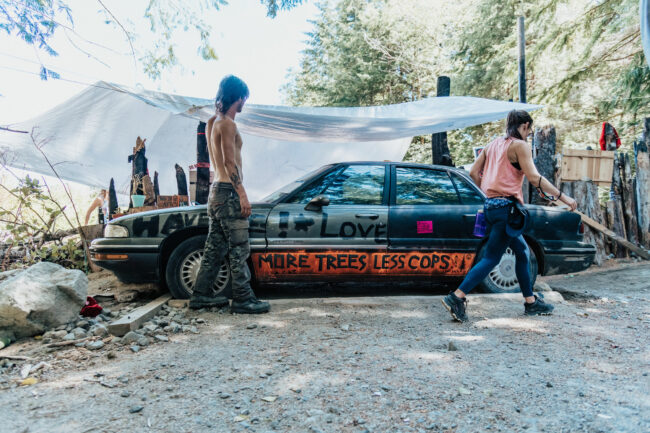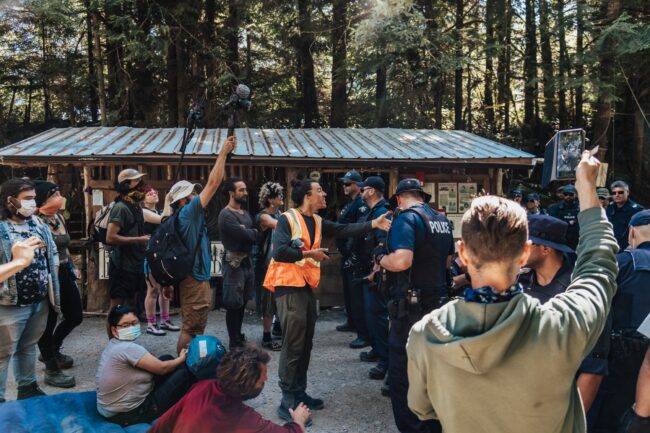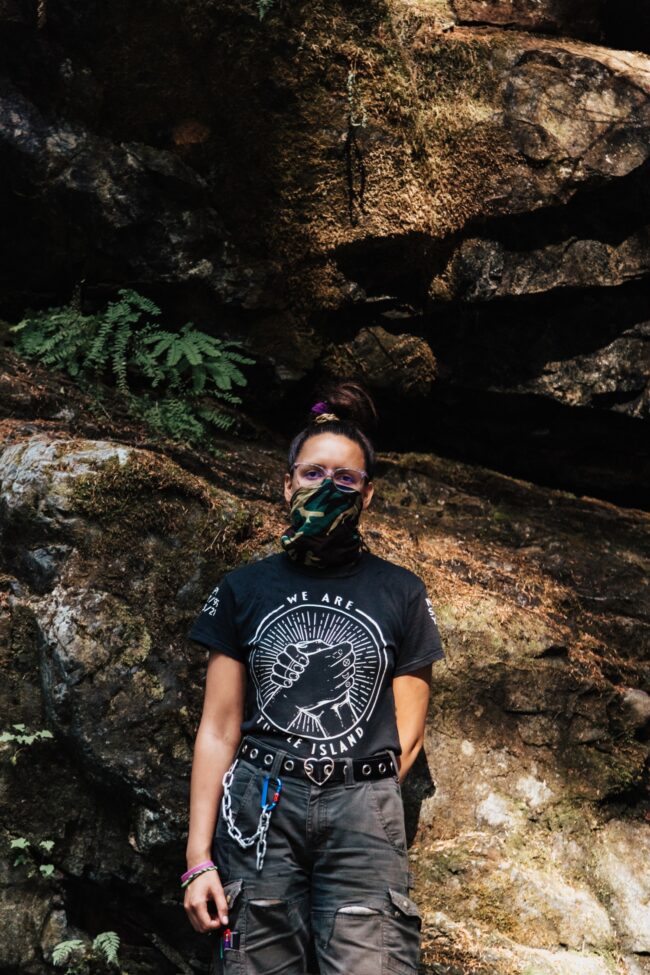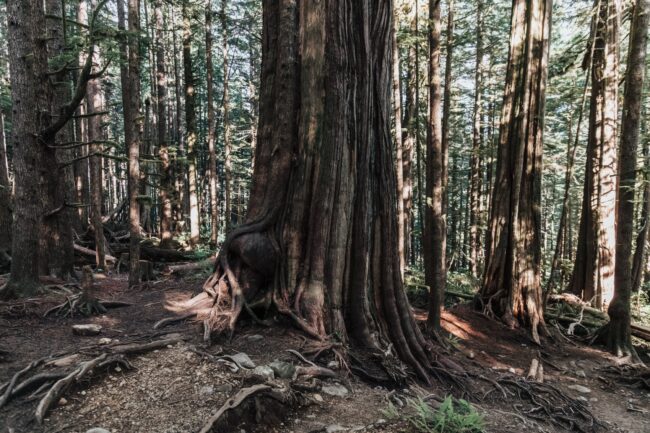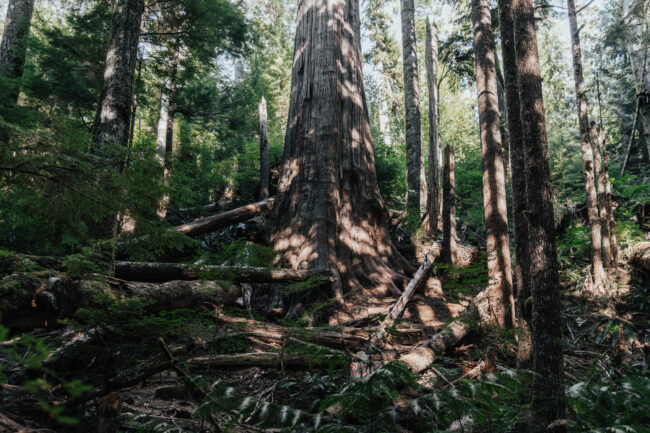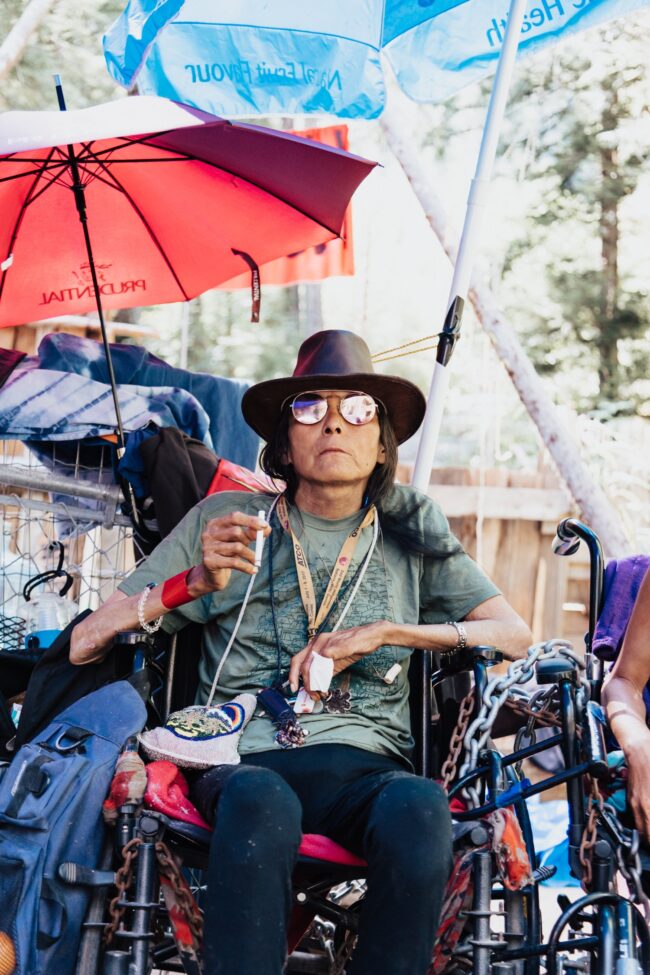
The Cleanest Line: Dispatch from Fairy Creek
Photographer: Agathe Bernard
Heidi: Fairy Creek is located on the territory of the Pacheedaht Nation, RCMP began enforcement of an injunction to clear forest defenders out of the way of logging company Teal Jones. The battle to protect this area is still ongoing, what drew you to this protest?
Agathe: In all honesty, when things started intensifying at Fairy Creek, I was swamped. I was working on a film about a double amputee going to the paralympics, pushing for the Sinixt (some of the Columbia River indigenous) to retrieve the rights back to their territories and get their voice heard through another film. I was working on a massive coastal cleanup. I didn’t have a lot of personal time then. I felt very isolated from the pandemic and in need of some girl time and community connection. So when Marie-France texted me to join her and Leah and a few other girlfriends, I knew deep down I had to show up, for the ecosystem, for the forest who gave me so much peace and to connect with the girls.
There were several female activists in your images; of course, men were present but was there a sisterhood afoot?
Definitively! It’s actually quite fascinating how Fairy Creek gathered so many caring women. When the police force was so intense, knowing that we had each other and could take care of each other and laugh, sharing food or resources was an absolute force. These friendships are forever changed and so much stronger because we shared that experience together. Building community, in this case, a sisterhood around the things you love and care for, I think is the key to flight for environmental and human justice.

Missing Murdered Indigenous Women MMIW is an essential and necessary movement that gives voice and raises awareness for mothers, daughters, sisters, wives and friends that have gone missing from reservations. What did you want your images to say and or how did making those photos hit you as a woman?
I was quite intimidated to take photos of these incredible indigenous women. Knowing how much they had been through and suffered and how hard it was for them to show up for their right in hopes of a better future for their daughters, sisters and grandchildren. That was a very humbling experience! In these images, I was trying to convey their fierce and strong nature, that enough is enough, and you just don’t mess with indigenous women, period. In each woman I could see a set of Russian dolls standing, lineage of generations standing into each woman and saying: “No more, we have had enough, and we will not put up with the abuse anymore”.
It was like drawing a clean line with the past, acknowledging the intergenerational trauma and choosing to end it at all cost. I still have shivers going through my body when I think of how I felt taking these photos. I still feel so much shame for our society to have allowed that to happen and so much anger when I look around and see how people keep ignoring the harm. Some photos will change you forever.
When you are in the forest, what type of energy or messages do you get from the trees?
The forest is hands down my favorite place to recalibrate. Bathing in big trees sparks my senses so much. I love observing the leaves unfolding and the sun sparkling through the branches, hearing the sounds of the wind passing through…I grew up playing in a forest every day and visited the big lumpy tree daily, wishing it well. That tree had motherly energy to it; it was comforting, safe, always there for me until they built the golf course. I still go by that same place when I go back East, and it’s sad now, endless rows of suburban houses that look all the same.
I was given my first film camera at seven, and the trees were the first thing I photographed. I feel like I still haven’t broken down the code to give them justice. I never thought of them as male or female; they are the perfect balance between standing solid and sturdy yet swaying with the wind and adapting beautifully like a gracious feminine dance. It’s the ideal mix between the feminine, caring quality of nurturing and community and the more individualistic strong male nature of pushing upward towards the light.
How has the environment and or the outdoors informed your work?
I grew up in nature between a forest, a river and a lake that was the city water reservoir. The environment was always everything for me. I was a little bit of a black sheep and felt quite lonely at times with all my passions and big dreams; nature was my safe place.
I was stealing my dad’s Handycam daily, wrapping it in my sweater on my way to school and making movies secretly. I stormed into the minister’s office at 13 with it and my concerns about pollution. I wanted answers because it didn’t make sense that we were polluting our planet with aerosols.
I brought one film to show my school. It was about the seal massacre in northern Quebec (my mom and sister had agreed to play the dead seal covered in ketchup). My parents were teachers, so they explained everything we saw: how the glaciers formed, the river flow, how everything evolved through time. I was raised with curiosity and a thirst to explore.
When I went to BC for the first time at 19th years old, I felt like I didn’t deserve to be enjoying the mountains. I didn’t understand why there were volcanoes amongst the coastal mountains, so I went to do a geology degree. That was a first-hand experience in seeing the inside of “the industry” that didn’t feel good. When I graduated, I worked in Peru, and our team was kidnapped. That experience was eye-opening, I was so naive. Eventually, I went to work as an environmental scientist specializing in contaminated soil and water, knee-deep cleaning up the industry’s pollutants. Unfortunately, because I was on the front line there, my health took a hit. I went back to school to do a graduate certificate in environmental education and communication. I feel like I am finally finding where I belong, bridging science and storytelling to show up for what I think is the most important. An incredible editor (you) told me once “you can express those motherly caring and loving qualities towards the causes you care for” and that is how I have resolved my own life purpose. Hopefully, seeing my work published and creating tiny ripples of change has brought me to hope that love, perseverance, and trust can do anything.
What message do you hope to share?
The balance with our environment is very fragile. Ecosystems are getting affected to a level they may not be able to recover, and I hope to help people understand we need to take better care of our mother. We need to look after her rivers, bring salmon back, leave the glacier alone, forbid development that brings crowds of selfie sticks, have the cruise ships gone so that whales can communicate, and regenerative design systems that prevent single-use plastics, hold industry accountable for ghost net and contamination, to name a few solutions.
Healing our mother comes hand in hand with healing social justice issues and healing ourselves because consumerism is a bandage. How much do we really need? What if we gave back the love our mother gave us?
Follow
@fairycreekblockade, @rainforestflyingsquad and @camplandback on Instagram, and visit facebook.com/FairyCreekBlockade for daily updates from the front lines.


